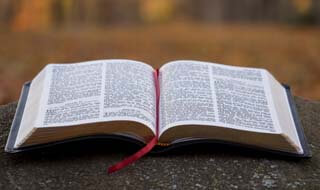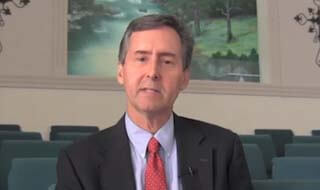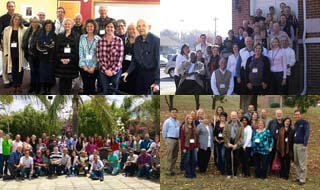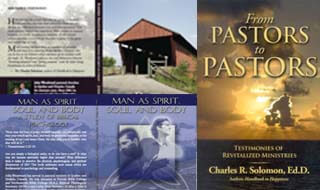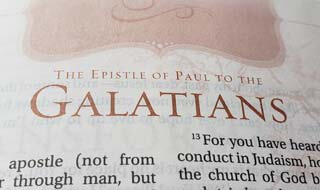[“Now this is the main point of the things we are saying: We have such a High Priest, who is seated at the right hand of the throne of the Majesty in the heavens, a Minister of the sanctuary and of the true tabernacle which the Lord erected, and not man …The first covenant had ordinances of divine service and the earthly sanctuary. For a tabernacle was prepared: the first part, in which was the lampstand, the table, and the showbread, which is called the sanctuary; and behind the second veil, the part of the tabernacle which is called the Holiest of All, which had the golden censer and the ark of the covenant overlaid on all sides with gold, in which were the golden pot that had the manna, Aaron’s rod that budded, and the tablets of the covenant; and above it were the cherubim of glory overshadowing the mercy seat. Of these things we cannot now speak in detail … But Christ came as High Priest of the good things to come, with the greater and more perfect tabernacle not made with hands, that is, not of this creation. Not with the blood of goats and calves, but with His own blood He entered the Most Holy Place once for all, having obtained eternal redemption. For if the blood of bulls and goats and the ashes of a heifer, sprinkling the unclean, sanctifies for the purifying of the flesh, how much more shall the blood of Christ, who through the eternal Spirit offered Himself without spot to God, cleanse your conscience from dead works to serve the living God?” Hebrews 8:1,2; 9:1-5,11-14] [1]
The Application to Christians
The section from verses 11-14 confronts us anew with the question raised above, What is the reality of which the tabernacle was a copy? Verse 11 says it was a greater and more perfect tabernacle … not man-made, … not a part of this creation. Verse 24 adds, he entered heaven itself, now to appear for us in God’s presence. We have already been given a clue to the meaning of this in 3:6, “For Christ is faithful as a son over God’s house. And we are his house.” He dwells within us as he said he would (John 14:23) and as Paul affirms (Eph. 3:16-17). The fact that this house is also termed heaven is difficult for us to grasp, since we tend to think of heaven spatially. It is “up there” or “out there” or even in some distant part of outer space.
If we would eliminate spatial terms from our thinking, we could come to think of heaven as simply another dimension of existence, as another realm of invisible realities just beyond our senses–in other words, the spiritual kingdom in which God, angels and even demons, function.[2] What the Bible seeks to teach us, and what is difficult for us to apprehend, is that we too can function in this dimension. It is the dimension of our spirits. Thus, Paul can say, “And God raised us up with Christ and seated us with him in the heavenly realms in Christ Jesus” (Eph. 2:6). Jesus tells us, “God is spirit, and his worshipers must worship in spirit and in truth” (John 4:24), and Paul adds, “He who unites himself with the Lord is one with him in spirit” (1 Cor. 6:17).
All of this strongly suggests that what Moses saw on the mountain was the human person as we are meant to be, the dwelling place of God–the Holy of Holies. John tells us in Revelation, “Now the dwelling of God is with men, and he will live with them. They will be his people, and God himself will be with them and be their God.”[21:3] If that language sounds reminiscent of the promises of the new covenant described in Hebrews 8, it is no accident. God had this in mind from the very beginning, as David declares in Psalm 8: “You made him [human beings] a little lower than the heavenly beings and crowned him with glory and honor.” These words, as we have seen, were quoted by the writer in 2:58 and to this, he appended: “Yet at present we do not see everything subject to him. But we see Jesus …” Jesus, as high priest of the good things that are already here, has found a way to repossess the human spirit and cleanse it with the “better sacrifice” of himself (9:23), and to dwell within forever by means of the eternal Spirit (9:14).
Moses saw, of course, the whole person–body, soul and spirit (Gen. 2:7; 1 Thess. 5:23). This would explain the threefold division of the tabernacle. The outer court corresponds to the body; the Holy Place, to the soul; and the Most Holy Place, to the spirit. Even the furniture of the tabernacle corresponds to elements in us. For instance, the furniture of the Holy Place was the lampstand, the table of bread, and the altar of incense. If the Holy Place is the soul of man, these pieces would suggest the mind (lampstand), the emotions (bread as a symbol of social intercourse) and the will (altar of incense, which reflects the choices God approves). But Moses was shown that though God dwells in the human spirit and makes us different from the animals, we have no access to him because of sin. We are described as “dead in trespasses and sins” and said to be “alienated from God,” “without God in the world.” But Paul states the great truth of Hebrews 9 in these words “But now in Christ Jesus you who once were far away have been brought near through the blood of Christ” (Eph. 2:13).
[“Therefore, brothers, since we have boldness to enter the sanctuary through the blood of Jesus, by the new and living way that He has inaugurated for us, through the curtain (that is, His flesh); and since we have a great high priest over the house of God, let us draw near with a true heart in full assurance of faith, our hearts sprinkled clean from an evil conscience and our bodies washed in pure water. Let us hold on to the confession of our hope without wavering, for He who promised is faithful. And let us be concerned about one another in order to promote love and good works, not staying away from our meetings, as some habitually do, but encouraging each other, and all the more as you see the day drawing near”- Heb. 10:9-15, HSCB*.]
~~~~~~~~~~~~~~~~~~~~~~~~~~~
The Believer as God’s Tabernacle (Part 2). Part one (by Martin Luther) is online at GraceNotebook.com.
This article is an excerpt from Hebrews, by Ray C. Stedman. The IVP New Testament Commentary Series. Consulting Editors D. Stuart Briscoe, Haddon Robinson. (InterVarsity Press, 1992), 97. http://www.pbc.org/dp/stedman/hebrews2/heb2comm1.html Contributed by Pierre Sinotte, Quebec, Canada
[1] Regarding the designation of the “golden censer” in verse 4, note this comment by Jamieson, Fausset and Brown: “golden censer–The Greek, must not be translated “altar of incense,” for it was not in “the holiest” place “after the second veil,” but in “the holy place”; but as in 2 Chron. 26:19, and Ezek. 8:11, “censer”: so Vulgate and Syriac. This GOLDEN censer was only used on the day of atonement (other kinds of censers on other days), and is therefore associated with the holiest place, as being taken into it on that anniversary by the high priest. The expression “which had,” does not mean that the golden censer was deposited there, for in that case the high priest would have had to go in and bring it out before burning incense in it; but that the golden censer was one of the articles belonging to, and used for, the yearly service in the holiest place. He virtually supposes (without specifying) the existence of the “altar of incense” in the anterior holy place, by mentioning the golden censer filled with incense from it: the incense answers to the prayers of the saints; and the altar though outside the holiest place, is connected with it (standing close by the second veil, directly before the ark of the covenant)…”- JBW
[2] Note 29 on Heb. 9:11. In equating the human spirit with heaven, I do not mean to imply that the human spirit in which the Spirit of Christ dwells is equivalent with all that Scripture includes in the word heaven. I simply mean that there is an obvious correspondence between the two and that in the spirit we are in some sense living in heaven now (Eph 2:6). – RCS
*Holman Christian Standard Bible


